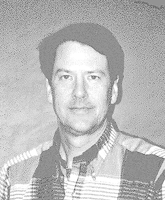New Editors for Two SIAM Journals
March 9, 2001

Former SIMA editor-in-chief Emmanuele DiBenedetto "put a lot of effort into quality control, and it shows," says his successor, Walter Strauss.
"We owe him tremendous thanks," Strauss says. "He put a lot of effort into quality control, and it shows." Strauss also credits DiBenedetto with a speedup of the entire publication process, which is now "much more efficient."
Strauss, for his part, would like not only to continue the forward momentum, but to "bring it up another notch, by being even stricter on quality." He views SIMA as being at the pinnacle of applied analysis journals. Also in his plans is a broadening of the scope of the journal, with respect to both the mathematics and the applications covered.
"The core of every SIMA paper should be top-quality, innovative analysis," Strauss says, but every paper should also have a connection to applications, "at least indirectly---but not too indirectly." For instance, an application could be to computational or approximation theory, or to the analysis of a classical model like the Navier-Stokes equations, but the journal also welcomes papers that include some modeling and numerics. A paper with strong potential for application could be acceptable, Strauss says, although one too far removed from applications would not.
The list of application areas in the journal's revised mission statement (fluid mechanics, materials science, quantum mechanics, biomathematics, among others) is not meant to be comprehensive, Strauss says, pointing out that he "would be delighted to have papers in such areas as financial mathematics and neuroscience," to name some other possibilities.
On the mathematical side, pointing out that the majority of SIMA papers have been in PDEs, the calculus of variations, approximation theory, and functional analysis, Strauss again envisions a broadening of SIAM's scope. Harmonic analysis, dynamical systems, and stochastic processes are possible new areas.
Other journals cover excellent work in analysis, and analysis with applications, Strauss says, but none has the top-notch analysis combined with the breadth of applications that he envisions for SIMA. "There's more than a niche---there's a big area---for SIMA, and we want people to think of us for their finest papers," he says.
*****
In January, Max Gunzburger became editor-in-chief of SIAM Journal on Numerical Analysis, succeeding Tom Manteuffel (whose two-year term as president of SIAM began in January). Here, the new editor-in-chief, who was recently named University Distinguished Professor at Iowa State University, offers some thoughts on the importance of numerical analysis today, and on the role he sees the journal---one of SIAM's earliest, dating back to 1964---playing in the continuing development of the field.


New SINUM editor-in-chief Max Gunzburger (top) sees the journal continuing to be "a place where new, useful, and rigorously justified algorithmic ideas are first introduced." His predecessor, Tom Manteuffel (right), has been president of SIAM since January 1. His thoughts from his new position appear in the "Talk of the Society" column.
SINUM is the premier journal in numerical analysis. Of course, this is due both to the high quality of submissions and to the unselfish efforts of the editors and referees who have maintained high standards. The leadership of the previous editors-in-chief has been instrumental in making SINUM what it is today.
I want to extend thanks especially, both personally and on behalf of the numerical analysis community, to Tom Manteuffel for his excellent stewardship of SINUM, from January 1996 through the end of 2000. My main goal as the new editor-in-chief is to ensure that SINUM maintains its central and preeminent role in the numerical analysis community.
In some circles, including some funding agencies, numerical analysis is not as highly valued as it once was. There are some who believe that today, with very complex multidisciplinary and multiscale problems becoming dominant, numerical analysis is no longer relevant. I firmly believe the opposite to be true. As problems get more complex, the presence of modeling and other errors increases. Thus, it is more important than ever to know that computational algorithms are stable, convergent, accurate, and efficient. And what better way to gain this knowledge than through rigorous analyses?
It used to be said (with some truth) that one could compute only problems for which one knew the answer; this made it easy to identify sources of error in a computation. But now, more than ever, we are solving problems for which we do not always have even qualitative information about the solution, so that we better make sure we know that the numerics are good. (On the other hand, of course, we must make sure that numerical analysis remains a relevant subject to other scientists and engineers.)
One conclusion that can be drawn from this discussion is that SINUM remains a central journal for all of scientific and engineering computing, and it is my hope that it will continue to be, as it has always been, a place where new, useful, and rigorously justified algorithmic ideas are first introduced.
Over time, the number of journals published by SIAM has increased dramatically. SINUM has spawned a number of the newer SIAM journals, in the sense that many of the papers that appear in those journals could well have been published in SINUM in times gone by. Certainly, this applies to SIOPT, SIMAX, and, to some extent, SISC. Furthermore, given the ubiquity of computing and computational approaches to solving problems, SINUM also has areas of overlap with most of the other SIAM journals. Many in the SIAM community feel that, as a result, SINUM has become narrower in its scope. Let me assure everyone that this has not been the case, nor is it the intention of the present SINUM editorial board. Without taking away from our sister journals, I want everyone to know that SINUM strongly encourages submissions in all areas of numerical analysis.
We are, of course, interested in algorithmic advances and analyses that apply to broad classes of problems. However, we are also interested in such developments that apply to specific complex applications, because, more often than not, such advances will have impact elsewhere as well. The only criterion we use at SINUM (in addition to the obvious need for correctness) is that a paper must contain a significant algorithmic advance that is supported with rigorous mathematical analyses. Supporting, illuminating, or illustrative computational results are also welcome and encouraged.
I do not assume the position of editor-in-chief with any specific agenda for changes in SINUM. I am not resistant to change, however, and am sure that over the next few years improvements can be made to SINUM that will further raise its stature. I would welcome any and all suggestions that readers may have for beneficial changes to SINUM.

